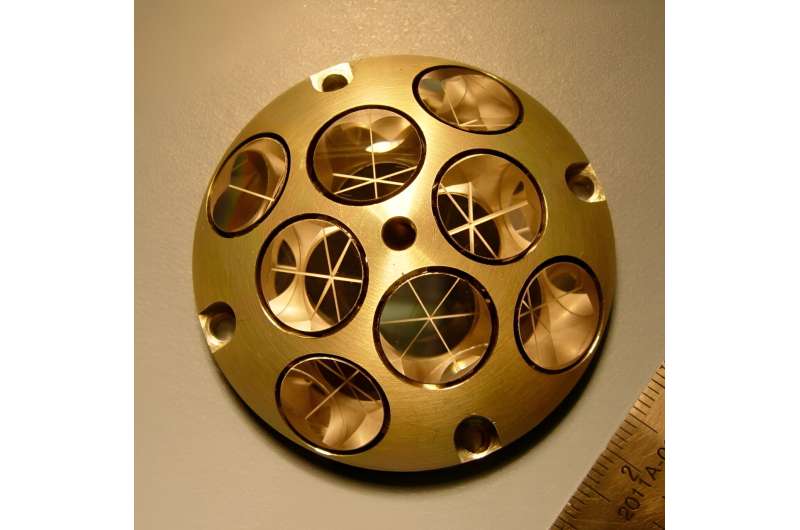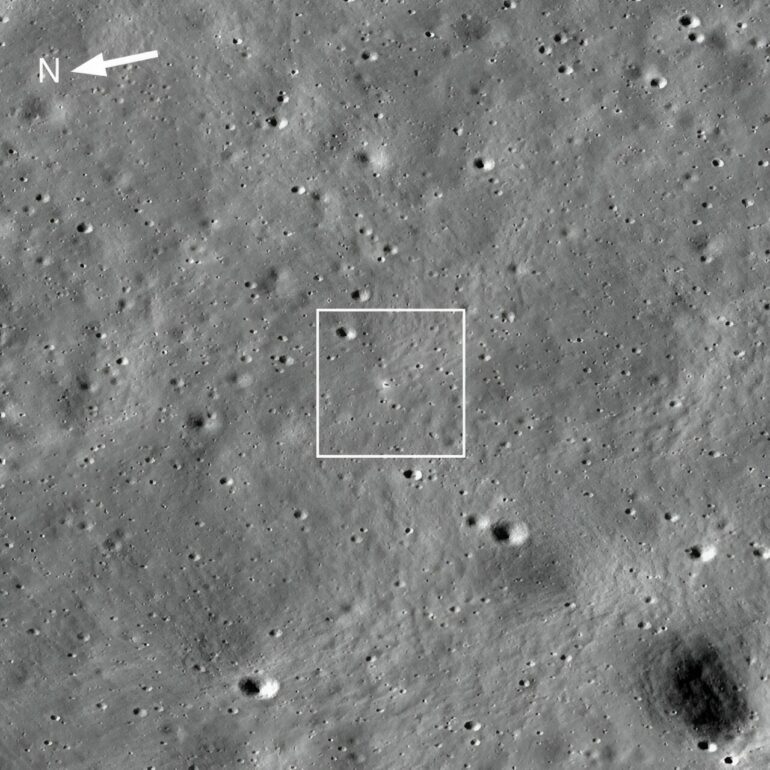For the first time at the moon, a laser beam was transmitted and reflected between an orbiting NASA spacecraft and an Oreo-sized device on ISRO’s (Indian Space Research Organization) Vikram lander on the lunar surface. The successful experiment opens the door to a new style of precisely locating targets on the moon’s surface.
At 3 p.m. EST on Dec. 12, 2023, NASA’s LRO (Lunar Reconnaissance Orbiter) pointed its laser altimeter instrument toward Vikram. The lander was 62 miles, or 100 kilometers, away from LRO, near Manzinus crater in the moon’s south pole region, when LRO transmitted laser pulses toward it. After the orbiter registered light that had bounced back from a tiny NASA retroreflector aboard Vikram, NASA scientists knew their technique had finally worked.
Sending laser pulses toward an object and measuring how long it takes the light to bounce back is a commonly used way to track the locations of Earth-orbiting satellites from the ground. But using the technique in reverse—to send laser pulses from a moving spacecraft to a stationary one to determine its precise location—has many applications at the moon, scientists say.
“We’ve showed that we can locate our retroreflector on the surface from the moon’s orbit,” said Xiaoli Sun, who led the team at NASA’s Goddard Space Flight Center in Greenbelt, Maryland, that developed the retroreflector on Vikram as part of a partnership between NASA and ISRO. “The next step is to improve the technique so that it can become routine for missions that want to use these retroreflectors in the future.”
Only 2 inches, or 5 centimeters, wide, NASA’s tiny but mighty retroreflector, called a Laser Retroreflector Array, has eight quartz-corner-cube prisms set into a dome-shaped aluminum frame. The device is simple and durable, scientists say, requiring neither power nor maintenance, and can last for decades. Its configuration allows the retroreflector to reflect light coming in from any direction back to its source.
Retroreflectors can be used for many applications in science and exploration and, indeed, have been in use at the moon since the Apollo era. By reflecting light back to Earth, the suitcase-size retroreflectors revealed that the moon is moving away from our planet at a rate of 1.5 inches (3.8 centimeters) per year.
This new generation of tiny retroreflectors has even more applications than their larger predecessors. On the International Space Station, they’re used as precision markers that help cargo-delivery spacecraft dock autonomously.

Only 2 inches, or 5 centimeters, wide, NASA’s Laser Retroreflector Array has eight quartz-corner-cube prisms set into a dome-shaped aluminum frame. This configuration allows the device to reflect light coming in from any direction back to its source. © NASA’s Goddard Space Flight Center
In the future, they could guide Artemis astronauts to the surface in the dark, for example, or mark the locations of spacecraft already on the surface, helping astronauts or uncrewed spacecraft land next to them.
But there’s more work to do before retroreflectors can light up the moon. The biggest hurdle to their immediate adoption is that LRO’s altimeter, which has operated for 13 years beyond its primary mission, is the only laser instrument orbiting the moon for now. But the instrument wasn’t designed to pinpoint a target; since 2009, the altimeter—called LOLA—has been responsible for mapping the moon’s topography to prepare for missions to the surface.
“We would like LOLA to point to this Oreo-sized target and hit it every time, which is hard,” said Daniel Cremons, a NASA Goddard scientist who works with Sun. It took the altimeter eight tries to contact Vikram’s retroreflector.
LOLA works by dispatching five laser beams toward the moon and measuring how long it takes each one to bounce back (the quicker the light returns, the less distance between LOLA and the surface, and thus the higher the elevation in that area). Each laser beam covers an area 32 feet, or 10 meters, wide, from a 62-mile, or 100-kilometer, altitude. Because there are large gaps between the beams, there is only a small chance that the laser pulse can contact a retroreflector during each pass of the lunar orbiter over the lander.
Altimeters are great for detecting craters, rocks, and boulders to create global elevation maps of the moon. But they aren’t ideal for pointing to within one-hundredth of a degree of a retroreflector, which is what’s required to consistently achieve a ping. A future laser that slowly and continuously rakes the surface without any gaps in coverage would help tiny retroreflectors meet their potential.
For now, the team behind NASA’s miniature retroreflectors will continue to use LRO’s laser altimeter to help refine the position of targets on the surface, especially landers.
Several NASA retroreflectors are slated to fly aboard public and private moon landers, including one on JAXA’s (Japan Aerospace Exploration Agency) SLIM lander, due to land on the moon on Jan. 19, 2024, and one built by Intuitive Machines, a private company scheduled to launch its spacecraft to the moon in mid-February. Intuitive Machines will carry six NASA payloads, including the retroreflector, under NASA’s Commercial Lunar Payload Services (CLPS) initiative.
Citation:
Laser instrument on NASA’s LRO successfully pings Indian moon lander (2024, January 19)



